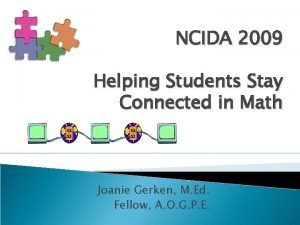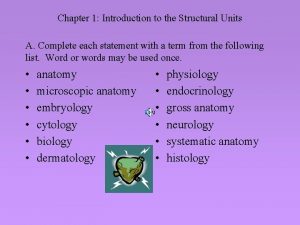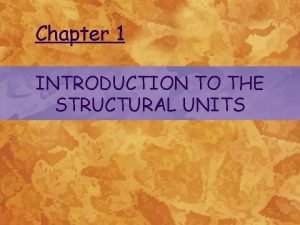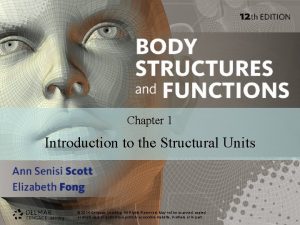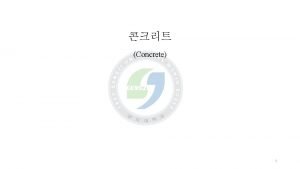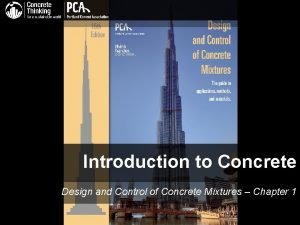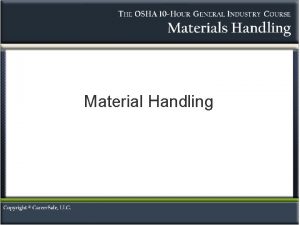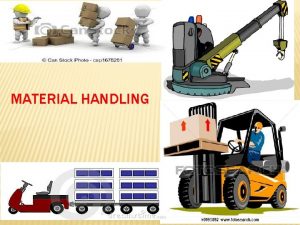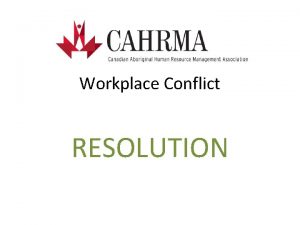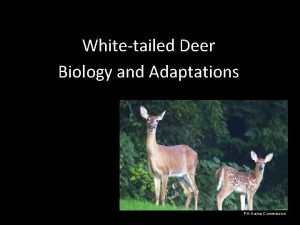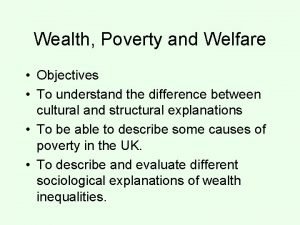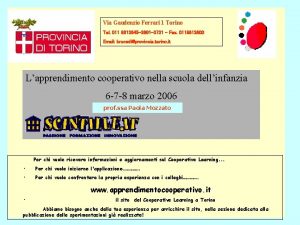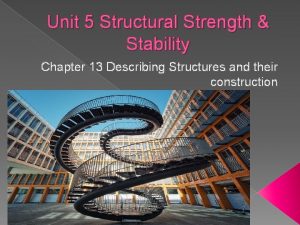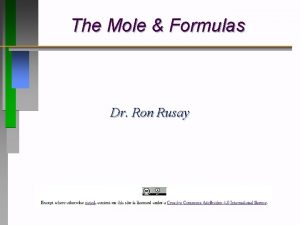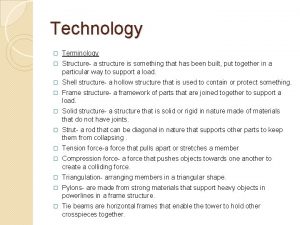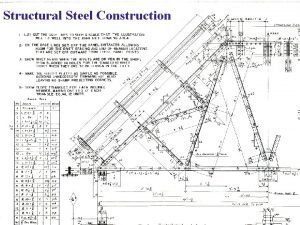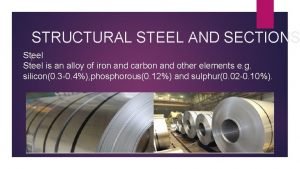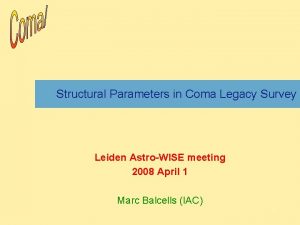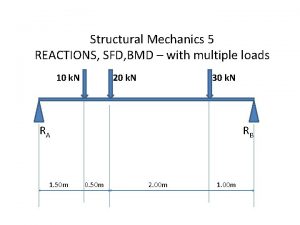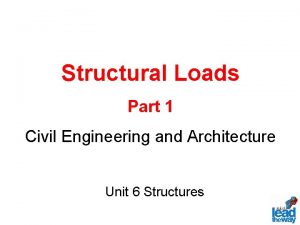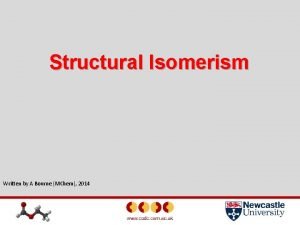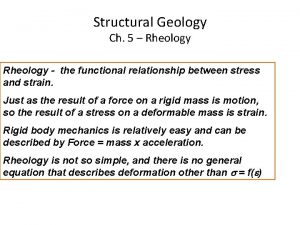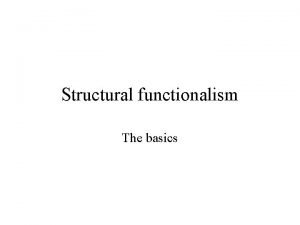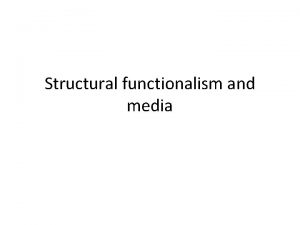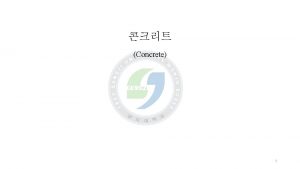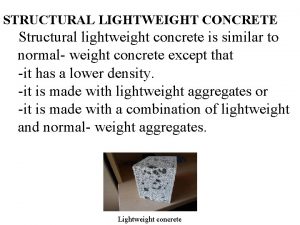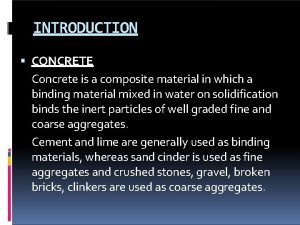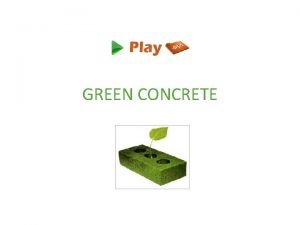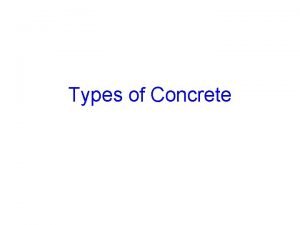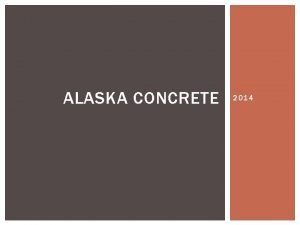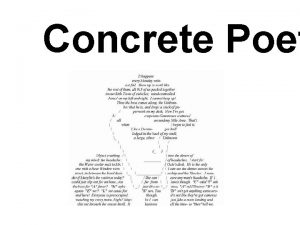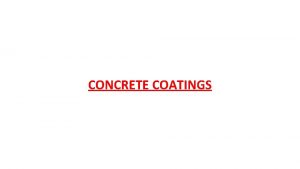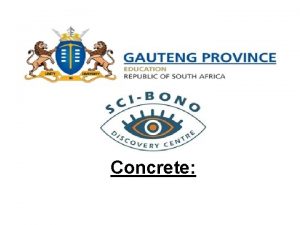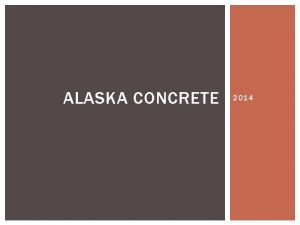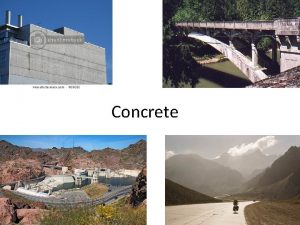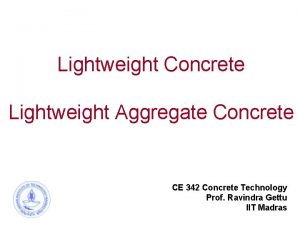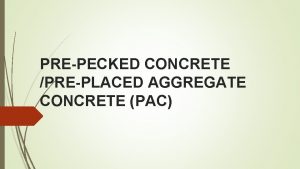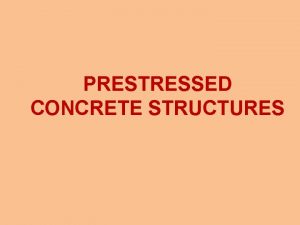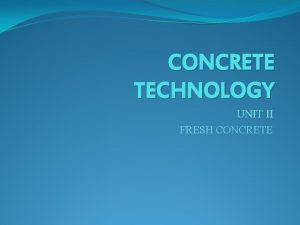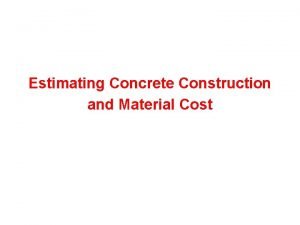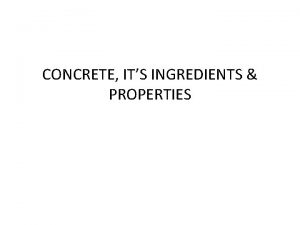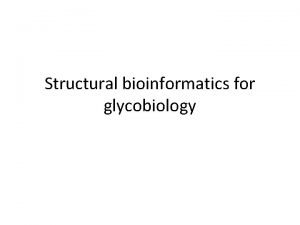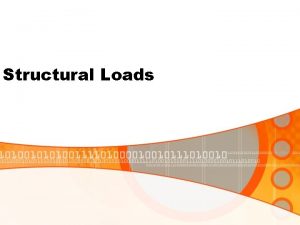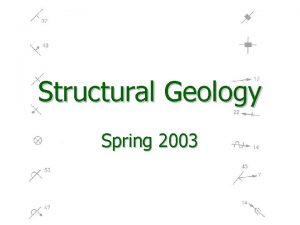Concrete 1 Introduction Concrete as a Structural Material







































- Slides: 39

콘크리트 (Concrete) 1


Introduction Concrete as a Structural Material CONCRETE (콘크리트) Coarse Aggregate (굵은 골재, 자갈) Fine Aggregate (잔골재, 모래) Cement paste (시멘트 풀) : Cement+Water CONCRETE STRUCTURES MATRIX + FILLER + FIBER Cement Paste Polymer Aggregate Mineral Powder Reinforcing steel Prestressing steel Fiber (Metal, Ceramic, Chemical) Mortar (모르타르)

www. sangji. ac. kr Concrete Lab of Sangji University 4

www. sangji. ac. kr i) Cohesiveness is how well concrete HOLDS TOGETHER when plastic. Cohesiveness is affected by: THE AGGREGATE GRADING Graded Aggregate means that there is a range of size of Aggregates, from large rocks to small sands. Well-graded Aggregates give a more cohesive mix, too much coarse Aggregate gives a boney mix. WATER CONTENT A mix that has too much water will not be cohesive and may separate and bleed. Curing is keeping concrete damp for a period, to allow it to reach maximum strength. Longer curing will give more durable concrete. WEATHER Warmer weather will cause concrete to have a higher early strength. TYPE OF CEMENT Different types of cement will affect concrete properties: ie how quickly or slowly concrete gains strength. THE WATER TO CEMENT RATIO Too much water and not enough cement means concrete will be weaker and less durable. The water to cement ratio (W/C) is the weight of the water divided by the weight of cement. Concrete Lab of Sangji University 5

www. sangji. ac. kr ii) Workability: Workability means how easy it is to: 1. Place 2. Handle 3. Compact and 4. Finish a concrete mix. Concrete that is stiff or dry may be difficult to Handle and, if not constructed properly, will not be as strong or durable when finally hardened. A slump test can be used to measure the workability of concrete. In design mix the worker should keep the following points in mind to achieve the desired degree of workability. • The amount of cement paste • Distance of transport • Strength and Durability • Method of placing • Loss of slump Concrete Lab of Sangji University 6

www. sangji. ac. kr The amount of cement paste: The cement paste is the soft or liquid part of the concrete mix. The more paste mixed with the coarse and fine Aggregates, the more workable a mix. The aggregate grading: Well-graded, smooth, rounded aggregates improve the workability of a mix. To make a more workable mix: Add more CEMENT PASTE. Use WELL GRADED aggregates. Admixtures: Use an ADMIXTURE. Never try to make a mixture more workable by just adding more water because this lowers the strength and durability of concrete. Concrete Lab of Sangji University 7

www. sangji. ac. kr iii) Strength: iv) Durability: Well made concrete is a naturally strong and durable material. It is DENSE, reasonably WATERTIGHT, able to resist changes in TEMPERATURE, as well as wear and tear from WEATHERING. Strength and Durability are affected by the density of the concrete. Denser concrete is more watertight (or less permeable). Concrete durability INCREASES with strength. Well made concrete is very important to protect the steel in reinforced concrete. v) Modulus of Elasticity: This property is used in all design, but it is seldom determined by test, and almost never as a regular routine test. For important projects, it is best to secure this information at least once, during the tests on the trial batches at the various curing ages. An accurate value will be useful in prescribing camber or avoiding unusual deflections. An exact value of Ec is invaluable for long- span, thin-shell construction, where deflections can be large and must be predicted accurately for proper construction and timing removal of forms. Concrete Lab of Sangji University 8

www. sangji. ac. kr vi) Volume change: Expansion and shrinkage Concrete has a very low coefficient of thermal expansion. However if no provision is made for expansion very large forces can be created, causing cracks in parts of the structure not capable of withstanding the force or the repeated cycles of expansion and contraction. As concrete matures it continues to shrink, due to the ongoing reaction taking place in the material, although the rate of shrinkage falls relatively quickly and keeps reducing over time (for all practical purposes concrete is usually considered to not shrink any further after 30 years). The relative shrinkage and expansion of concrete and brickwork require careful accommodation when the two forms of construction interface. Because concrete is continuously shrinking for years after it is initially placed, it is generally accepted that under thermal loading it will never expand to it's originally-placed volume. Concrete Lab of Sangji University 9

www. sangji. ac. kr Concrete states: Concrete has three different states: 1. Plastic 2. Setting 3. Hardening In each state it has different properties. 1) Plastic State: When the concrete is first mixed it is like 'bread dough'. It is soft and can be worked or moulded into different shapes. In this state concrete is called PLASTIC. Concrete is plastic during placing and compaction. The most important properties of plastic concrete are workability and cohesiveness. A worker will sink into plastic concrete. 2) Setting State: Concrete then begins to stiffen. The stiffening of concrete, when it is no longer soft, is called SETTING. Setting takes place after compaction and during finishing. Concrete that is sloppy or wet may be easy to place but will be more difficult to finish. A worker leaves footprints in setting concrete. 3) Hardening State : After concrete has set it begins to gain strength and harden. The properties of hardened concrete are strength and durability. Hardened concrete will have no footprints on it if walked on. Concrete Lab of Sangji University 10

www. sangji. ac. kr 양질의 콘크리트 (Good Uniform Concrete) Concrete Lab of Sangji University 11


www. sangji. ac. kr Properties of fresh concrete (굳지않은 콘크리트의 성질) ■ Fresh concrete (굳지않은 콘크리트) : 물, 시멘트, 골재, 공기, 혼화재료의 혼합물 ■ 작업단계 : mixing → transporting → placing → compacting → finishing 비비기 운반 치기 다지기 마무리 ㄱ) 재료의 균일한 분포 ㄴ) 완전한 다짐 ■ Fresh concrete의 성질 a) workability (워커빌리티) : ㄱ) consistency (반죽질기) ㄴ) mobility(유동성) ㄷ) compactibility(다짐성) Concrete has three different states: 1. Plastic (소성) 2. Setting (응결) 3. Hardening (경화) b) stability (안정성) : ㄱ) segregation(골재분리) ㄴ) bleeding(블리딩) c) Cohesiveness(응집성) is how well concrete HOLDS TOGETHER when plastic. Concrete Lab of Sangji University 13


www. sangji. ac. kr ● Workability에 영향을 주는 인자 a) 구성재료의 특성과 배합비 (시멘트, 단위수량, 잔골재, 굵은골재, 혼화재료, 온도) b) ambient conditions ; temperature, humidity, wind velocity c) mixing 과 compaction 사이의 시간 d) 운반 및 다짐 방법 e) 거푸집의 크기, 형상, 표면조직 f) 철근의 양과 치수 ● Workability의 측정 a) slump 시험(slump test) 1913년, 미국, chapman 개발 ∙ slump값이 3 ~ 18 cm의 경우 적당 ∙ 다짐봉 ψ16 mm, L = 50 cm 강봉 Concrete Lab of Sangji University workability test of concrete Slump test Kelly ball test K slump test Vee bee consistometer test Flow table test. 15

www. sangji. ac. kr a) Slump Test (슬럼프 시험) Concrete Lab of Sangji University 16

www. sangji. ac. kr b) Vee bee consistometer Test Procedure for Vee bee Consistometer: 1. Insert the Slump cone in the attached cylindrical container. Fill the concrete sample in the cone in four layers; each layer should be one-quarter of the height of slump cone and tamped with tamping rod for 25 strokes each. After tamping the top layer, struck off the concrete with a trowel making the cone correctly filled. 2. After filling the concrete in the slump cone, the transparent glass disc attached to a swivel arm is moved and placed on the top surface of the concrete and Note the reading from the graduated scale as an “initial reading” 3. And then remove the cone slowly in the vertical direction and wait until the concrete settles in the new position. 4. Again move the swivel arm and place it on the lowered concrete for the final reading. Note it as “final reading” 5. Now, switch on the vibrator and start the stopwatch. The vibrations are continued until the concrete is wholly remoulded i. e, the surfaces become horizontal and the whole concrete surface adheres uniformly to the transparent disc. The time required for complete remoulding in seconds is recorded. 6. Note the time taken by concrete to become horizontal (remoulding) as Vee bee Secs. The consistency of concrete is measured as Vee bee Secs. You can refer the below video for more details: Concrete Lab of Sangji University 17

www. sangji. ac. kr Workability c) Kelly ball test (구관입시험) 지름 6인치의 주철제 반구(半球)에 눈금이 매겨진 막대를 붙인 것이며, 전체 중량은 30 파운드. 이것을 흙손으로 끝손질한 콘크리트면 위에 조용히 놓고, 콘크리트 속으로 들어가는 깊이를 구하여 컨시스턴시의 척도로 한다. 콘크리트의 깊이가 15㎝ 이상, 면적의 최소 치수가 30㎝ 이상의 경우에 사용 Procedure for Kelly ball test: 1. Freshly mixed concrete (test sample) is poured into a container up to a depth of 20 cm. Once the container is filled with the concrete, the top surface is leveled and struck off. 2. The Kelly ball setup is kept on concrete as shown below by holding the handle of hemisphere such that the frame touches the surface of the concrete. 3. Ensure that the setup is kept at minimum 23 cm away from the container ends. (Place at the middle portion of the container) 4. Now release the handle and allow the ball to penetrate through the concrete. Once the ball is released, the depth of penetration is immediately shown in the graduate scale to the nearest 6 mm. 5. Note down the depth of penetration from the attached graduated scale. 6. Repeat the same experiment for three times at different portions in the container and average the value. Average Value of the reading = Slump value Concrete Lab of Sangji University 18

www. sangji. ac. kr Workability d) flow test(흐름시험) : flow table과 mould(윗지름 17. 1 cm, 밑지름 25. 4 cm, 높이 12. 7 cm) 이용 2층 각회 다짐 15초 동안 15회 낙하후 펼쳐진 지름 측정 ** Slump Flow Test for Concrete : 콘크리트 슬럼프 흐름시험 Concrete Lab of Sangji University 19

www. sangji. ac. kr e) K Slump Test Procedure of K Slump Test: 1. Wet the tester and clean it with a cloth. 2. Raise the plastic tube let it sit on the pin support. 3. Take a container and pour some fresh concrete and level it. 4. Now insert the k slump tester vertically down until the disc floater rests at the surface of the concrete. Do not rotate while inserting or removing the K slump tester. 5. Wait for 60 seconds, lower the measuring rod slowly until it rests on the surface of the concrete that has entered the tube and read the slump value directly on the scale of the measuring rod Concrete Lab of Sangji University 20

www. sangji. ac. kr Stability ․ consistency, cohesiveness 의 영향을 받는다 i) concrete 의 uniformity를 나타내는 성질 ii) 구성하는 성질 a) segregation(재료의 분리) b) bleeding iii) segregation ․ solid particle 의 크기와 비중차이 ․ solid particle 의 비표면적 ․ 모르타르의 양 a) 지나친 wet and dry b) deficiencies in sand 특히 finer 인 경우 c) 운반 도중의 심한 충격 Concrete Lab of Sangji University 21



www. sangji. ac. kr Hardened concrete(경화콘크리트)의 성질 ․Strength : 압축강도․전단강도․휨강도․인장강도․부착강도 ․Deformation : 단기 탄성변형․장기하중에 의한 장기변형 ․Shrinkage (건조수축) ․Durability내구성) : freezing & thawing ( weathering chemical attack internal chemical reaction Concrete Lab of Sangji University 24

www. sangji. ac. kr Strength(강도) Concrete Lab of Sangji University 25

www. sangji. ac. kr Strength(강도) Concrete Lab of Sangji University 26


철근의 탄성계수(Elastic Modulus of Reinforcements) : Reinforcing steel : Es=200, 000 Mpa =200 GPa Prestressing steel : Eps=200, 000 MPa =200 GPa Structural steel : Ess=210, 000 MPa =210 GPa

www. sangji. ac. kr Strength(강도) Concrete Lab of Sangji University 29

www. sangji. ac. kr Strength(강도) Concrete Lab of Sangji University 30

www. sangji. ac. kr Strength(강도) Concrete Lab of Sangji University 31

www. sangji. ac. kr 전단강도 (shear strength), 剪斷强度 Concrete Lab of Sangji University 32

www. sangji. ac. kr 휨강도 (Flexure strength) or 파괴계수(Modulus of Rupture) Concrete Lab of Sangji University 33

www. sangji. ac. kr 인장강도 (Tensile Strength) Concrete Lab of Sangji University 34

www. sangji. ac. kr 인장강도 (Tensile Strength) Concrete Lab of Sangji University 35

www. sangji. ac. kr Concrete Lab of Sangji University 36


www. sangji. ac. kr Deformation(변형) Concrete Lab of Sangji University 38

www. sangji. ac. kr Deformation(변형) Concrete Lab of Sangji University 39
 Scip structural concrete insulated panels
Scip structural concrete insulated panels Informal inventory
Informal inventory Concrete semi concrete abstract
Concrete semi concrete abstract Geometric characteristic symbols
Geometric characteristic symbols Variance analysis meaning
Variance analysis meaning Popular culture example
Popular culture example Refers to the knowledge language values customs
Refers to the knowledge language values customs All groups create norms to enforce their cultural values.
All groups create norms to enforce their cultural values. Useful and harmful materials in home
Useful and harmful materials in home Chapter 1 introduction to the structural units answer key
Chapter 1 introduction to the structural units answer key Introduction to the structural units
Introduction to the structural units Introduction to the structural units
Introduction to the structural units Introduction of concrete
Introduction of concrete Introduction of concrete
Introduction of concrete Material handling introduction
Material handling introduction Introduction of material handling
Introduction of material handling Intro paragraph outline
Intro paragraph outline Structural conflict
Structural conflict White-tailed deer adaptations
White-tailed deer adaptations Whats an adaptation
Whats an adaptation Functionalism strengths
Functionalism strengths Manatee structural adaptations
Manatee structural adaptations Structural poverty
Structural poverty Structural approach di kagan
Structural approach di kagan Structural strength and stability
Structural strength and stability Major structural components of the english spelling system?
Major structural components of the english spelling system? Condensed structural formula of formaldehyde
Condensed structural formula of formaldehyde What are structural lines in fashion
What are structural lines in fashion Is a cell phone tower a frame structure
Is a cell phone tower a frame structure Taxonomy of bugs in software testing
Taxonomy of bugs in software testing Energy methods in structural analysis
Energy methods in structural analysis Edge distance for bolts
Edge distance for bolts Compound fink truss
Compound fink truss Structural coma
Structural coma Bmd
Bmd Structural efficiency
Structural efficiency C5h12 structural isomers
C5h12 structural isomers Geology
Geology Advantages and disadvantages of functionalism
Advantages and disadvantages of functionalism Teori fungsionalisme
Teori fungsionalisme

